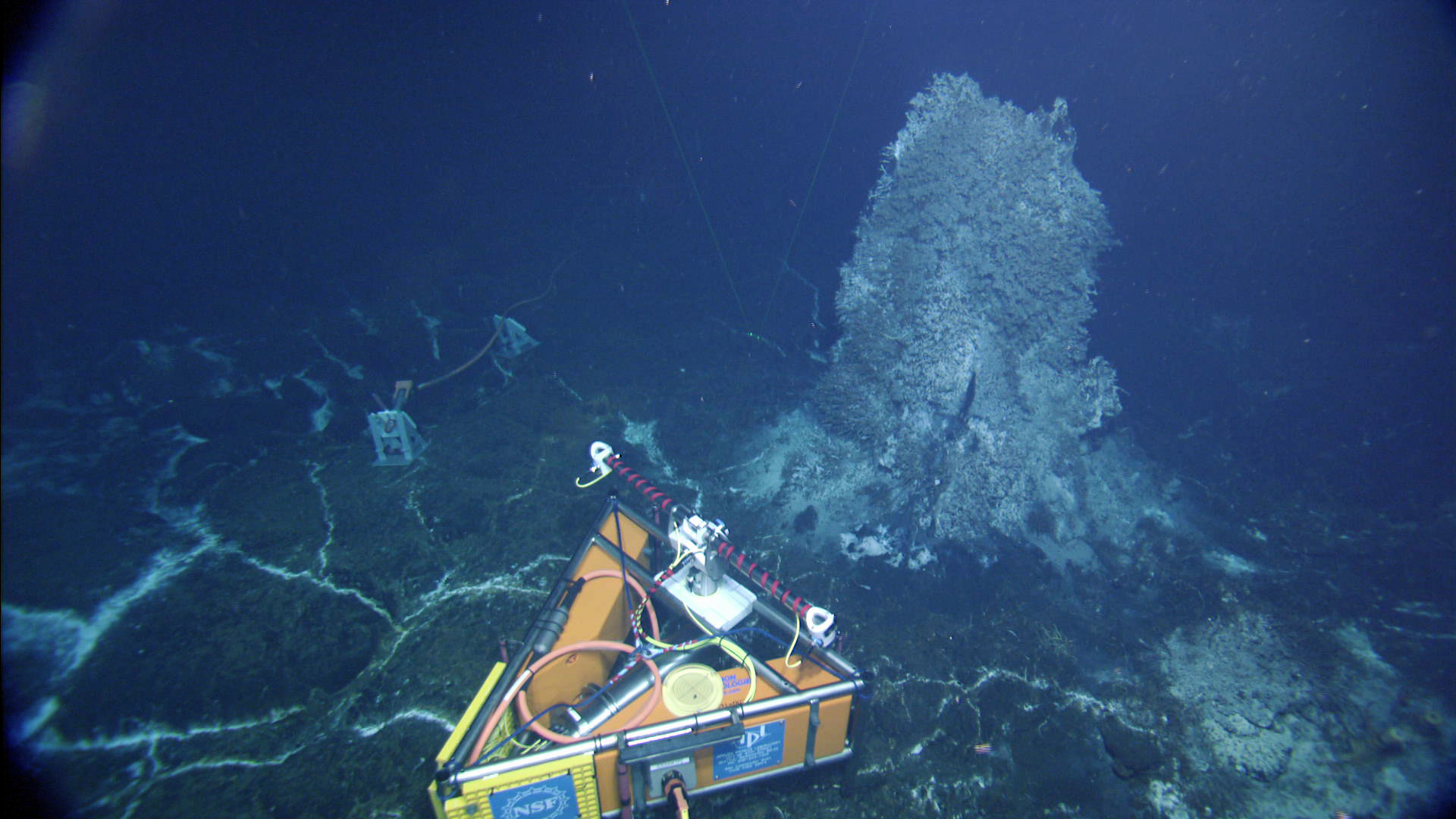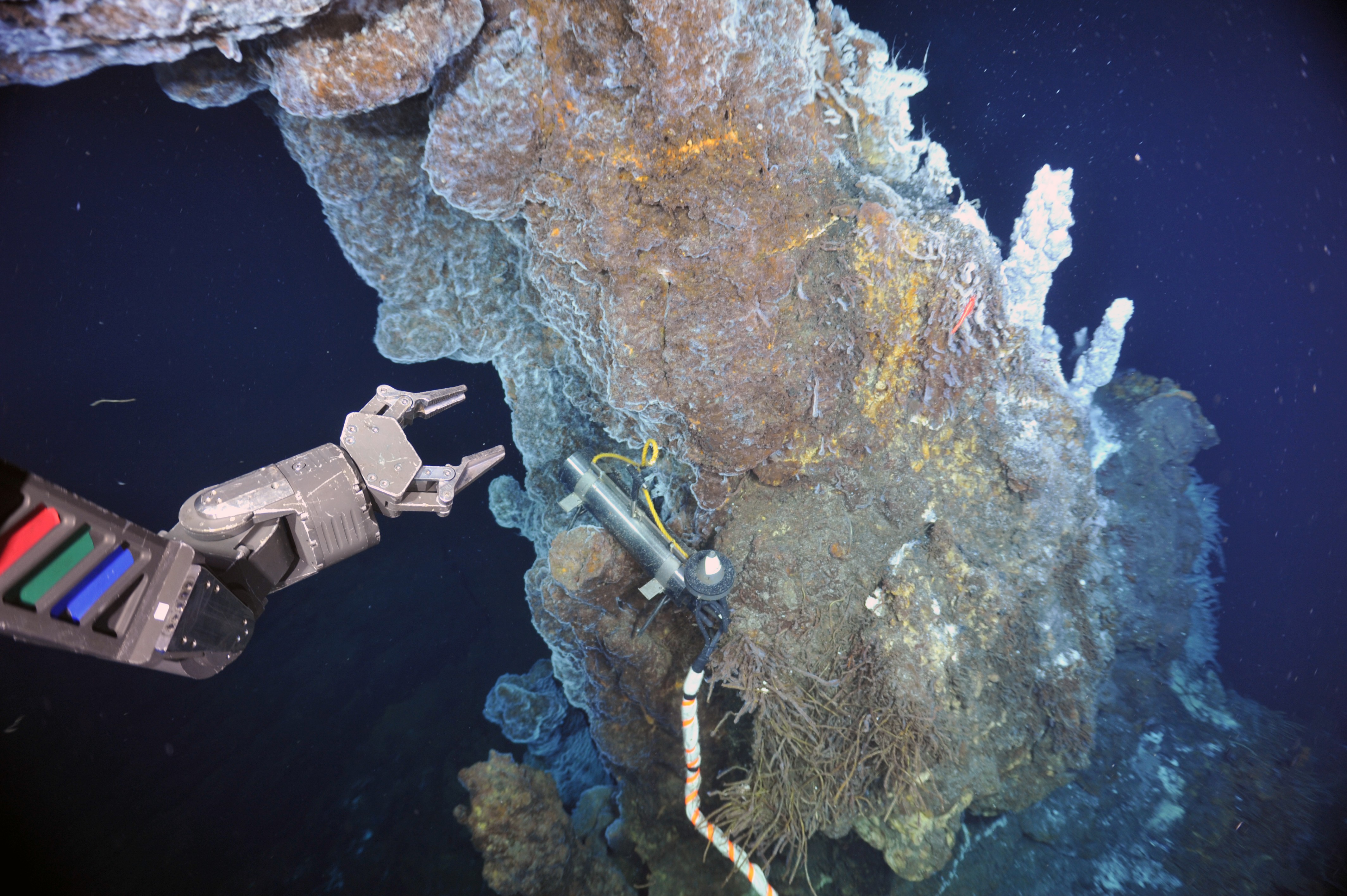Image Archive







The RCA high definition camera at the base of the hydrothermal vent called Mushroom. Credit: UW/NSF-OOI/CSSF; ROPOS Dive R1636; V13.

During VISIONS'13 two types of flow meters (CAT and Mosquito) were deployed at the summit of Southern Hydrate Ridge near the Einstein's Grotto active seep site - each instrument has specific ranges of flow that they measure. They will be recovered in 2014, providing year-long records of flow into and out of the sediment. Credit: UW/OOI-NSF//CSSF; V13

A resistivity-temperature probe, developed by Dr. Marv Lilley at the University of Washington, was deployed into a 270°C actively venting orifice on the chimney called Escargot. Resistivity is an analogue for chlorinity. Some of the vents in the International District are boiling, causing release of very gas-rich, low-salinity fluids. This instrument, recovered on ROPOS dive 1638, was deployed on a small ledge on the structure a few weeks previously with power provided by batteries in the titanium housing. The orange-white taped cable leads to the wand that is inserted into the chimney (not shown in this image). The white, feathery material on the outside of the chimney is filamentous bacteria, supported by low-temperature diffuse fluids that waft up the side of the chimney. Photo credit: NSF-OOI/UW/CSSF

An Argo Float just being released from the R/V Thompson during the VISIONS'13 program. It will collect chemical measurements to depths of 1000 m, surfacing every 5-10 days to transmit these data back to shore via a satellite. Photo Credit: Mitch Elend, University of Washington.

University of Washington, School of Oceanography undergraduate student - Charlie Parker- deploys an Argo float over Axial Seamount during the VISIONS'13 program. The float wil submerge to 1000 m beneath the surface, taking chemical measurements along the way, and every 5-10 days will surface and transmit these data over a satellite to shore. Photo Credit: Mitch Elend, University of Washington.

This short-period seismometer was deployed on a flat sheet flow ~ 1.3 km east of the ASHES hydrothermal field in 2013. The black ball in the yellow circle shows that it is perfectly level, helping to insure that the highest quality data comes off of this network. Axial Volcano is likely to be quite seismically active and we are anxious to get the real-time data on shore next year. This will help us understand magma and fluid migration in the subsurface of the volcano...and eventually these data may help us predict an eruption. Several earthquakes were detected in real-time during testing of these seismometers in 2013. Credit: UW/NSF-OOI/CSSF, ROPOS Dive R1635; V13.
- Anemone
- Animal
- Arthropod
- ASHES
- Axial
- Axial Base
- Axial Biology
- Axial Caldera
- Bacteria
- Basalt Lava
- BEP
- Biofouling
- biolgoy
- Biology
- Camds
- Camera
- Camhd
- Central Caldera
- Ciliates
- Cnidaria
- Coastal Biology
- Crab
- Deep Profiler Mooring
- Dive Highlights
- Eastern Caldera
- Echinoderms
- Endurance Array
- Engineering Team
- ENLIGHTEN 10
- Exploratorium
- Fish
- Geology
- HD Camera
- HPIES
- Hydrate Ridge
- Hydrates
- Hydrophone
- Hydrothermal Vents
- Illustration
- Inshore 80 Meters
- Instrument
- International District
- J-BOX
- Jason
- Jellyfish
- Junction Box
- K12
- Lava
- Mollusk
- Moorings
- Nodes
- Nudibranch
- Octopus
- OOI
- Oregon Offshore
- Oregon Offshore 600 m
- Oregon Shelf
- Oregon Slope Base
- People
- PN1B
- PN1D
- Polychaetes
- PPSDN
- Primary Node
- RASFL
- ROCLS
- ROPOS
- ROPOS Dives
- ROV Team
- RV Revelle
- RV Sikuliaq
- RV Thompson
- Salp
- Sample
- SC13
- Science Team
- Sea Cucumber
- Sea Star
- Sea Urchin
- Seafloor
- Seismometer
- Sensors
- Shallow Profiler Mooring
- Shark
- Shipboard
- Shore Station
- Slope Base
- Smoker
- Soft Coral
- Southern Hydrate Ridge
- Sponge
- Squid
- Students
- Students & Guest Participants
- Tmpsf
- Tubeworms
- VISIONS 11 Leg 1
- VISIONS 11 Leg 2
- VISIONS 11 Viewers
- VISIONS 13
- VISIONS 14
- VISIONS 15
- VISIONS 16
- VISIONS 17
- VISIONS 18
- VISIONS 20
- VISIONS 22
- VISIONS 23
- Visualization
